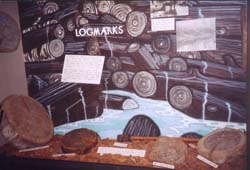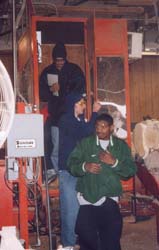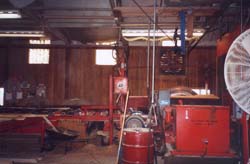
Home
- Artifacts
- Buildings & Businesses
- Churches
- Holidays & Celebrations
- Counties/Locations
- Delta College
- Early Settlers
- Ethnic Background
- Local, Michigan, U.S. and World Events
- Family Genealogy
- Farming
- Libraries & Museums
- Local Sites
- Logging
- Musicians, Artists & Famous People
- Nature, Weather & Four Seasons
- Railroads
- Schools
- Sports
The Impact of Lumbering and Railroads in Early Michigan
 |
Years ago as a youngster, I went with my family on vacations in the northern parts of Michigan. Dad said the big pine stumps that dotted the landscape were a testimony to the vast white pines that once stood in this great state. These stumps are a significant reminder of the importance lumbering had on the development of Michigan. As the pine stumps grow scarcer with each passing year, there are still a couple places you can go to view their great history. Hartwick Pines State Park, in Grayling, and the Lumbermen's Monument on the AuSable River are two places that tell the tale of years past. When people talk about the lumbering era, they think about the heyday years of the late 1800s and the early 1900s, when Michigan produced billions of board feet of lumber and made many men very wealthy. It was a time when lumber had the greatest impact on the development of Michigan, and the railroads would play a big role in transporting the logs, lumber and other supplies throughout the state.
Background of Lumbering
 |
Photo from "Logmarks" exhibit at Castle Museum of Saginaw County History |
Logging in Michigan started well before the big boom years of the 1850s and beyond. "In 1837, the year Michigan became a state, 435 sawmills were doing business; all but eighty-seven were located in the lower four tiers of counties" (Maybee 43). During those years lumber and wood was needed to build houses and make tools for farming, because almost everything was made of wood, from wagons and sleighs to pails and barrels. As this country's population continued to climb, there was greater demand for lumber as new towns were being developed. "By 1840 it was apparent that the traditional sources of white pine in Maine and New York would be unable to supply a growing demand for lumber" (Quinlan 1).
 |
Michigan moved into the commercial lumbering business around 1840. With all of the rivers and streams in Michigan, building sawmills along them was the logical choice. Through the 1840s and early 1850s logging was primarily a winter job, because snow and ice roads were needed to transport logs from the cutting area to the banking grounds on the river banks. This was done with horses and large sleds by the lumberjacks who worked in the woods. "Lumberjacks, most often single men in their twenties, spent the winter in the woods, working from dawn till dusk six days per week, cutting, hauling, and piling logs". Quinlan also states, "They were usually paid between $20 and $26 per month and were also provided room and board" (3). Sunday being their only day off in the lumber camp, the entertainment was typically singing and story telling. The legendary Paul Bunyan and Babe, his blue ox, is an example of one such story that probably derived from within one of these camps.
"The demand for Michigan's pine lumber soared when the Illinois and Michigan canal connecting Chicago with the Mississippi River was completed in 1848" (Bajema 43). The
population in Michigan also continued to grow. " Between 1840 and 1870 Michigan loggers came primarily from New York, Ohio, New England and Pennsylvania" ( Quinlan 3). Immigrants also played a big role in the population increase. Maria Quinlan explains how immigrants helped increase the states population:
*The lumber camps were also manned by individuals from many ethnic groups. Near the end of the nineteenth century, however, the number of Scandinavians entering the state increased dramatically; the number of Swedish immigrants, for example, which was a mere sixteen in 1850, had grown to 9,412 by 1880, and stood at 26,374 in 1910. During these same decades there was a corresponding influx of Scandinavians into the lumber camps (3)*
The rising population in this country and the need for more lumber created yet another problem. "Mild winters in 1848, 1849 and 1850 prevented lumbermen in the Grand and Muskegon river valleys from getting logs to their sawmills fast enough to supply Chicago merchants with lumbar for customers living on the prairies" (Bajema 43). This necessitated a need for a new method of transporting logs to the sawmills would have to come and soon.
The Change In Transportation
The unpredictable winters of the late 1840s, and the deforestation in the close proximity to major rivers and streams encouraged lumbermen to find new ways to curtail the costs of transporting logs. " In 1874 recapitulation of the cost break down of logs at a typical mill showed that 73.5% of the cost represented charges directly attributed to transportation" ( Koch 15). Even before the 1874 transportation figures came out men were already experimenting with different
modes of transportation. "In 1850 two Grand River valley lumbermen attempted to speed up the process of moving logs from the skid ways to the banking grounds by constructing wooden railroads and using horses to pull car loads of logs" (Bajema 43). This process was slow but still got the job done and prompted others to continue looking at alternatives to the big sled.
Through the 1860s, as technology increased, the use of water sprinklers to freeze the sled tracks enabled loggers to haul larger loads, but this did not solve the problem. The importance of finding new methods of transporting logs became obvious when the steam-powered mills began to spring up and vastly increased their lumber output. "Greater mill capacity coupled with the continuing demand for wood also put pressure on the loggers to cut as much as possible each season" (Quinlan 2).
With the continuing changes in steel technology the cross cut saw soon replaced the ax as the preferred tool for felling trees, increasing the production in the woods that much greater. The problem of getting the increased production of logs to the mills still existed. "Two Michigan-initiated innovations of the 1870s were responsible for the largest increase in logging production. The Big Wheels invented by Silas Overpack and the "narrow gage railroad" (Quinlan 3). These inventions allowed logging to become a year-round operation. Experiments with wooden railed railroads and tram roads went on until 1877. The tram roads were cheap to build and were nothing more than planks laid end to end or logs held in place by stakes. The locomotives and log cars that used the tram roads had concave wheels which kept them on the poles. These tram roads brought logs either to the mills or main line railroads.
As the main line railroads continued to expand and push north the idea of hauling logs on a railroad didn't happen until "1872 when during a severe dry spell, the Flint and Pere Marquette
railroad carried 12,769,515 feet of logs" ( Koch 15). One of the biggest problems at this time was the mills were built along the rivers and the railroads did not have access to them.
According to Michael Koch; "In 1874 George Campbell and Hugh Campbell of Bay City, Michigan, formed the Glencoe, Pinconning and Lake Shore Railroad Company for the purpose of bringing logs to the mills at Pinconning and cut lumber from the same mills to the shores of the Saginaw Bay for direct shipment by water. . . By 1877, the line showed an operating deficit of $8,581.54" (16). This railroad was adjacent to my former property at 4891 N. Garfield Road, Pinconning, Michigan. It is right of way now and has been for many years owned by Consumers Power.
Before the use of railroads, due to the high cost of shipping, only the choicest trees were cut. A man by the name of Winfield Scott Gerish changed all that after attending "the great Centennial Exposition at Philadelphia. While there he was fascinated by a small Baldwin locomotive" (Maybee 38), which is a wood burning steam engine. In 1877, Scott Gerish opened "The Lake George and Muskegon River Railroad" ( Maybee 39). The railroad that Gerish opened was such a huge success hauling logs to the banking grounds of the Muskegon River and making such large profits, it prompted other lumbermen to follow his lead. "In 1882, thirty-two of these narrow-gage logging railroads were constructed in Michigan, and by 1889 there were eighty-nine such logging railroads in operation, totaling almost 450 miles of track" (Maybee 41). With the success of the narrow-gage railroads delivering logs to main line railroads, several of the lumbermen moved their mills from the rivers to operate next to the main line railroads.
The Economical Impact on The State
The economical effect that lumbering had on Michigan was enormous. As Maria Quinlan states, "The Saginaw Valley was the leading lumber area between 1840 and 1860, when the number of mills in operation throughout the states doubled and the value of their products increased from $1 million to $6 million annually. Rapid growth continued and by 1869 the Saginaw Valley alone was earning $7 million yearly" (1). Through the years, from 1840 to 1900, well over 200 billion board feet of lumber of various varieties were produced.
The railroads also had a hand in the economy. Not only did they haul logs and people, they also delivered hard wood timbers for ship building and furniture manufacturing. Spin-off companies employed many people making train cars, and steel wheels for them. The railroads were also used in the Upper Peninsula hauling iron and copper ore to the shipping ports of Lakes Superior and Michigan.
The Ecological Impact on The State
 |
| Delta College students exiting the laser saw booth after seeing a modern saw in action. |
As great as the economical impact the railroads had on the state, it could easily be overlooked by the damaging ecological effects that were left in its wake. The logging railroads allowed lumber companies to clear cut every tree that stood. They also went into areas that were cut previously before the railroad and stripped the remaining trees that were there too. " Wood-burning locomotives opened up the state for logging and settlement, but the sparks and embers that they threw set many a wood on fire" ( Dickman & Leefers 151). In the wake of the clear cutting there was nothing left to protect the soil, which allowed for some devastating erosion. Some people tried farming the barren lands, but in many areas the soil was just too poor to support crops. " The Conservation Programs in effect today on state lands grew out of concern over the conditions the loggers had left behind them" ( Quinlan 5).
Today, railroads still play a role in the transportation in various products; however, the logging railroads are gone, replaced by trucks with diesel-engines and rubber wheels. Logging had a great impact on the development of Michigan's economy. With the continuing evolution of technology, today logging continues with one man and a multi-million dollar machine. They can cut as much wood in one week as a whole lumber camp cut in a year in the 1800s. That is when logging and railroads had the greatest impact on the development of Michigan.
 |
| Machinery at a modern sawmill, Willsie Lumbering, in Freeland, Michigan. |
Works Cited
- Bajema, Carl. "Timber Express." Michigan History. Nov./Dec. 1993: 42-46.
- Dickman, Donald, and Larry Leefers. The Forest of Michigan. Ann Arbor: Univ. of Mich. UP, 2003.
- Koch, Michael. The Shay Locomotive. Denver, CO: The World Press, Inc. 1971.
- Maybee, Rolland. Michigan White Pine Era. Lansing, MI: Mich. Historical Com., 1976.
- Quinlan, Maria. "Lumbering in Michigan." Lumbering in Michigan-Background Reading. History, Arts and Libraries. 5 Jun. 2003. 24 Nov. 2004.
<http://www.michipan.gov/hal/0,1607,7-160-17451 18793-53133--,00.htm1>.
| The written and visual works in Mid-Michigan Remembers-Stories about Us were chosen on the basis of their quality, diversity, community interest and appeal. Views expressed do not necessarily reflect those of the College. This space is provided as a service by Delta College. |